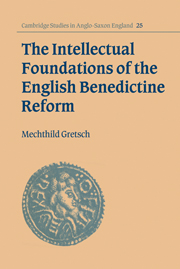Book contents
- Frontmatter
- Contents
- Preface
- List of abbreviations
- 1 Introduction
- 2 Psalters and psalter glosses in Anglo-Saxon England
- 3 The vocabulary of the Royal Psalter
- 4 The Royal Psalter and the Rule: lexical and stylistic links
- 5 The Aldhelm glosses
- 6 Word usage in the Royal Psalter, the Rule and the Aldhelm glosses
- 7 Æthelwold and the Old English Rule
- 8 Æthelwold and the Royal Psalter
- 9 Æthelwold and the Aldhelm glosses
- 10 French and German loan influence
- 11 Conclusion
- Appendix I Æthelwold's life and career
- Appendix II The Royal Psalter at Canterbury
- Appendix III The Gernrode fragments of an Old Saxon psalm commentary
- Bibliography
- Index of Old English words
- Index of Latin words
- General index
4 - The Royal Psalter and the Rule: lexical and stylistic links
Published online by Cambridge University Press: 01 October 2009
- Frontmatter
- Contents
- Preface
- List of abbreviations
- 1 Introduction
- 2 Psalters and psalter glosses in Anglo-Saxon England
- 3 The vocabulary of the Royal Psalter
- 4 The Royal Psalter and the Rule: lexical and stylistic links
- 5 The Aldhelm glosses
- 6 Word usage in the Royal Psalter, the Rule and the Aldhelm glosses
- 7 Æthelwold and the Old English Rule
- 8 Æthelwold and the Royal Psalter
- 9 Æthelwold and the Aldhelm glosses
- 10 French and German loan influence
- 11 Conclusion
- Appendix I Æthelwold's life and career
- Appendix II The Royal Psalter at Canterbury
- Appendix III The Gernrode fragments of an Old Saxon psalm commentary
- Bibliography
- Index of Old English words
- Index of Latin words
- General index
Summary
The terminus ante quem for the origin of the Royal gloss is obviously set by the manuscript in which it is preserved, which, on palaeographical grounds, must be dated no later than the mid-tenth century. Textcritical and linguistic grounds would seem to preclude an origin of the gloss considerably earlier than the date of the manuscript. It is clear that the text as transmitted in Royal 2. B. V is very close to the original gloss, and, while it is true that a later manuscript may occasionally preserve a better text than an earlier one, such an assumption is ruled out for Royal 2. B. V by the language of the gloss: the language is clearly not early West Saxon, nor does it preserve any traces of an earlier West Saxon layer of glosses.
To my knowledge, an ascription of the Royal gloss to Æthelwold's circle and more specifically to one or several of his Abingdon monks (or monks from Abingdon accompanying him to Winchester) has been made (tentatively) only once, namely by Karl Wildhagen. His reasons for this were threefold: the presence in the manuscript of liturgical pieces, such as the Gloria in excelsis or the Quicumque uult, the remarkable quality of the gloss itself and the occurrence of phonological features pertaining to the Anglian dialect. As regards the first two points, for Wildhagen the Royal Psalter represented the first fruit of the intellectual revival occasioned by the Benedictine reform (the ‘erste Frucht der neuen Schulung’).
- Type
- Chapter
- Information
- Publisher: Cambridge University PressPrint publication year: 1999

